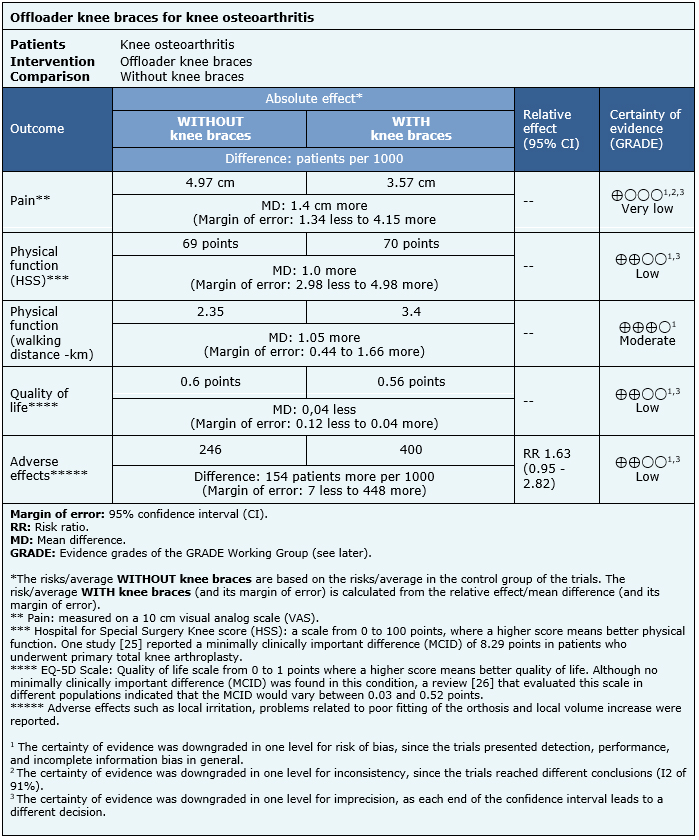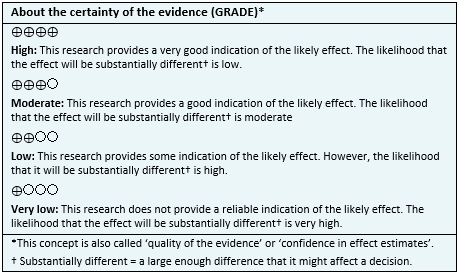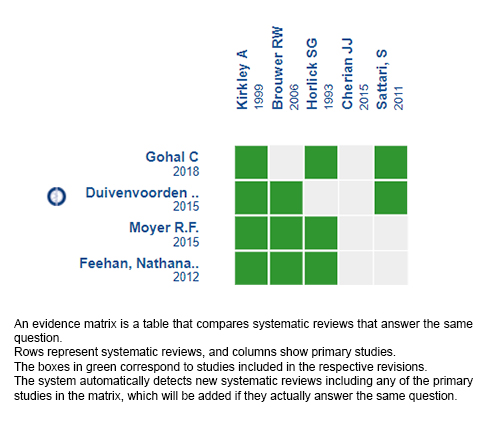Resúmenes Epistemonikos
← vista completaPublicado el 28 de abril de 2021 | http://doi.org/10.5867/medwave.2021.03.8114
Uso de órtesis de rodilla con refuerzo en descarga en artrosis de rodilla.
Offloader knee braces for knee osteoarthritis
Abstract
INTRODUCTION Knee osteoarthritis is a relevant health problem given its high prevalence and associated disability. Within the non-pharmacological management alternatives, the use of offloader knee braces has been proposed, however, there is no consensus in the literature regarding its indication.
METHODS We searched in Epistemonikos, the largest database of systematic reviews in health, which is maintained by screening multiple information sources, including MEDLINE, EMBASE, Cochrane, among others. We extracted data from the systematic reviews, reanalyzed data of primary studies, conducted a meta-analysis and generated a summary of findings table using the GRADE approach.
RESULTS AND CONCLUSIONS We identified 14 systematic reviews including nine studies overall, all of which were randomized trials. We conclude that the use of offloader knee braces in patients with knee osteoarthritis probably increases physical function through walking distance. However, its use may make little or no difference to physical function measured with the Hospital for Special Surgery Knee score, it may slightly worsen the quality of life and increase adverse events, but the certainty of the evidence is low. In addition, we are uncertain whether the use of offloader knee braces reduces pain as the certainty of the evidence has been assessed as very low.
Problem
Osteoarthritis is a relevant health problem, with hip and knee osteoarthritis being the eleventh leading cause of global disability, the thirty-eighth in years of life adjusted for disability [1], and an important reason for consultation in both primary and specialist care.
Conservative management is the first line of treatment, within which the use of knee braces has been considered. There are five main types of knee orthoses: prophylactic, which protects the knee from injury; functional, supporting the injured knee; rehabilitation, which limits harmful movement after injury or surgery; patellofemoral, which helps the patella move smoothly; and offloader knee braces. This last one is used in knee osteoarthritis since it allows to partially offset the misalignment of varus or valgus deformities, which increases the degenerative process and symptoms in the femorotibial compartments of the knee.
The use of this type of orthosis is intended to reduce pain, improve physical function and possibly delay the progression of the disease, however, its mechanisms and effects are not clear and its clinical use is highly variable, so there is no consensus in the literature on its indication.
Methods
We searched in Epistemonikos, the largest database of systematic reviews in health, which is maintained by screening multiple information sources, including MEDLINE, EMBASE, Cochrane, among others, to identify systematic reviews and their included primary studies. We extracted data from the identified reviews and reanalyzed data from primary studies included in those reviews. With this information, we generated a structured summary denominated FRISBEE (Friendly Summary of Body of Evidence using Epistemonikos) using a pre-established format, which includes key messages, a summary of the body of evidence (presented as an evidence matrix in Epistemonikos), meta-analysis of the total of studies when it is possible, a summary of findings table following the GRADE approach and a table of other considerations for decision-making.
|
Key messages
|
About the body of evidence for this question
|
What is the evidence. |
We identified 14 systematic reviews [2], [3], [4], [5], [6], [7], [8], [9], [10], [11], [12], [13], [14], [15] including nine primary studies [16], [17], [18], [19], [20], [21], [22], [23], [24], all of which corresponds to randomized trials. This table and the summary in general are based on six randomized trials [17], [18], [20], [22], [23], [24], since three trials [16], [19], [ 21] were excluded from the analysis due to their study design (cross-over). |
|
What types of patients were included* |
All trials [17], [18], [20], [22], [23], [24] included adult patients with diagnosis of symptomatic knee osteoarthritis (pain). The average age ranged from 46 to 63.1 years and on average, 57.1% of the included patients were men.Three trials [17], [22], [23] reported the average body mass index of their patients, which varied between 27.2 and 29.8 Kg/m2. Regarding the severity of osteoarthritis on radiography, one trial [22] evaluated patients with knee osteoarthritis graded 1 to 4 in Kellgren-Lawrence scale and two trials [18], [24]only patients with Kellgren-Lawrence 3 and 4. All trials included patients with osteoarthritis of the medial compartment and two trials [17], [18] also included patients with osteoarthritis of the lateral compartment. |
|
What types of interventions were included* |
All trials [17], [18], [20], [22], [23], [24] evaluated the use of an offloader knee brace. All trials [17], [18], [20], [22], [23], [24] had a parallel design, comparing against a control group with knee osteoarthritis that did not receive the treatment. |
|
What types of outcomes |
The trials evaluated multiple outcomes, which were grouped by the systematic reviews as follows:
|
* Information about primary studies is not extracted directly from primary studies but from identified systematic reviews, unless otherwise stated.
Summary of findings
The information on the effects of the use of offloader knee braces in knee osteoarthritis is based on two trials [17], [24] including 177 patients, since there was not sufficient information to include the remaining trials [18], [20], [22], [23] in the analyses.
Two trials [17], [24] measured pain (177 patients), one trial [17] measured physical function with the Hospital for Special Surgery Knee score and quality of life (117 patients), two trials [17], [24] measured physical function through walking distance (177 patients) and one trial [17] measured adverse effects (117 patients).
The summary of findings is as follows:
- We are uncertain whether the use of offloader knee braces reduces pain as the certainty of the evidence has been assessed as very low.
- Use of offloader knee braces may make little or no difference to physical function measured with the Hospital for Special Surgery Knee score (low certainty evidence).
- Use of offloader knee braces probably improves physical function evaluated through walking distance (moderate certainty evidence).
- Use of offloader knee braces may slightly wosen quality of life (low certainty evidence).
- Use of offloader knee braces may slightly increase adverse effects (low certainty evidence).

| Follow the link to access the interactive version of this table (Interactive Summary of Findings – iSoF) |

Other considerations for decision-making
|
To whom this evidence does and does not apply |
|
| About the outcomes included in this summary |
|
| Balance between benefits and risks, and certainty of the evidence |
|
| Resource considerations |
|
| What would patients and their doctors think about this intervention |
|
|
Differences between this summary and other sources |
|
| Could this evidence change in the future? |
|
How we conducted this summary
Using automated and collaborative means, we compiled all the relevant evidence for the question of interest and we present it as a matrix of evidence.

Follow the link to access the interactive version: Offloader knee bracing for knee osteoarthritis.
Notes
The upper portion of the matrix of evidence will display a warning of “new evidence” if new systematic reviews are published after the publication of this summary. Even though the project considers the periodical update of these summaries, users are invited to comment in Medwave or to contact the authors through email if they find new evidence and the summary should be updated earlier.
After creating an account in Epistemonikos, users will be able to save the matrixes and to receive automated notifications any time new evidence potentially relevant for the question appears.
This article is part of the Epistemonikos Evidence Synthesis project. It is elaborated with a pre-established methodology, following rigorous methodological standards and internal peer review process. Each of these articles corresponds to a summary, denominated FRISBEE (Friendly Summary of Body of Evidence using Epistemonikos), whose main objective is to synthesize the body of evidence for a specific question, with a friendly format to clinical professionals. Its main resources are based on the evidence matrix of Epistemonikos and analysis of results using GRADE methodology. Further details of the methods for developing this FRISBEE are described here (http://dx.doi.org/10.5867/medwave.2014.06.5997)
Epistemonikos foundation is a non-for-profit organization aiming to bring information closer to health decision-makers with technology. Its main development is Epistemonikos database (www.epistemonikos.org).
Potential conflicts of interest
The authors do not have relevant interests to declare.

